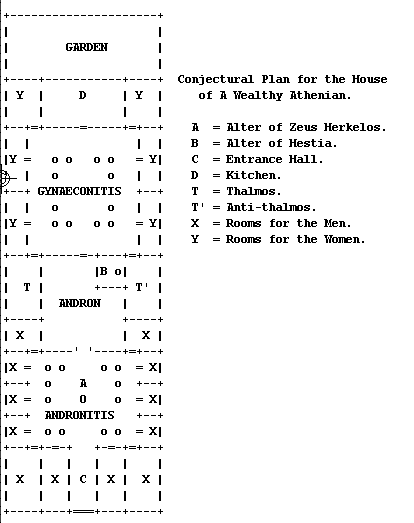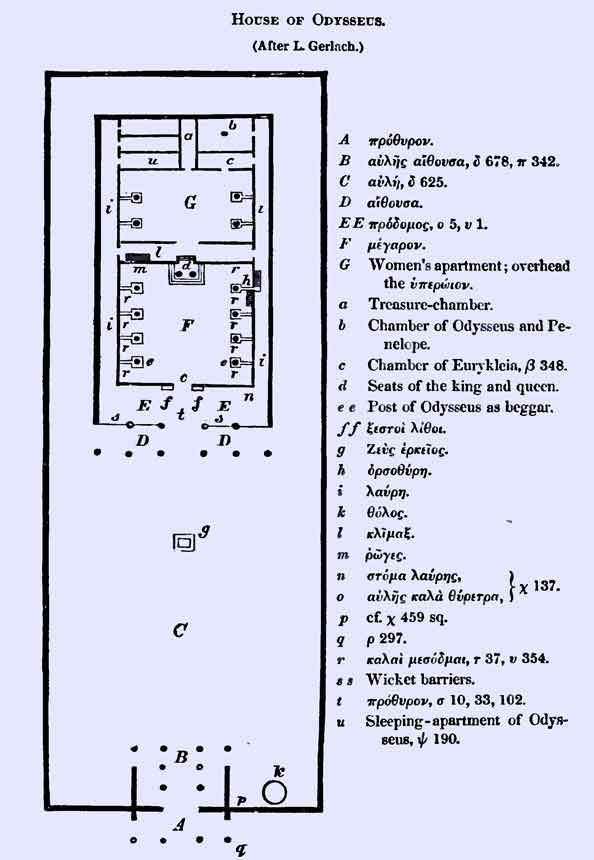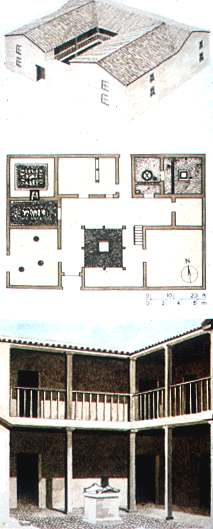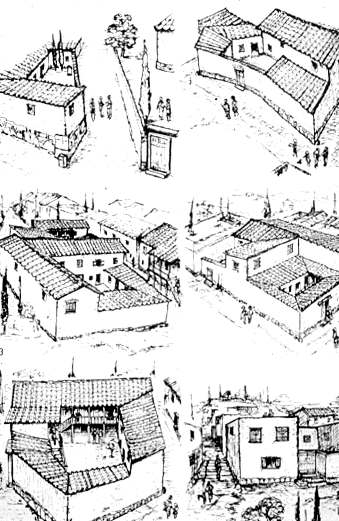.
Häuser und Möbel im antiken Griechenland
Part 2
Oikos a Greek word for "house, habitation" from which the word ecumene is derived "the inhabited world " and economy (household management)
From a Gutenberg Text File A Day in Old Athens, William Stearns Davis, Professor of Ancient History in the University of Minnesota:
Chapter IV. The Athenian House and its Furnishings.
21. Following an Athenian Gentleman Homeward.--Leaving the Agora and reentering the streets the second impression of the residence districts becomes more favorable. There are a few bay trees planted from block to block; and ever and anon the monotonous house walls recede, giving space to display some temple, like the Fane of Hephestos[*] near the Market Place, its columns and pediment flashing not merely with white marble, but with the green, scarlet, and gold wherewith the Greeks did not hesitate to decorate their statuary.
[*]Wrongly called the "Theseum" in modern Athens.
At street corners and opposite important mansions a Hermes-bust like those in the plaza rises, and a very few houses have a couple of pillars at their entrances and some outward suggestion of hidden elegance.
We observe that almost the entire crowd leaving the Agora goes on foot. To ride about in a chariot is a sign of undemocratic presumption; while only women or sick men will consent to be borne in a litter. We will select a sprucely dressed gentleman who has just been anointed in a barber's shop and accompany him to his home. He is neither one of the decidedly rich, otherwise his establishment would be exceptional, not typical, nor is he of course one of the hard-working poor. Followed by perhaps two clean and capable serving lads, he wends his way down several of the narrow lanes that lie under the northern brow of the Acropolis[*]. Before a plain solid house door he halts and cries, "Pai! Pai!" ["Boy! Boy!"]. There is a rattle of bolts and bars. A low-visaged foreign-born porter, whose business it is to show a surly front to all unwelcome visitors, opens and gives a kind of salaam to his master; while the porter's huge dog jumps up barking and pawing joyously.
[*]This would be a properly respectable quarter of the city, but we do not know of any really "aristocratic residence district" in Athens.
As we enter behind him (carefully advancing with right foot foremost, for it is bad luck to tread a threshold with the LEFT) we notice above the lintel some such inscription as "Let no evil enter here!" or "To the Good Genius," then a few steps through a narrow passage bring us into the Aula, the central court, the indispensable feature of every typical Greek house.
22. The Type and use of a Greek House.--All domestic architecture, later investigators will discover, falls into two great categories—of the northern house and the southern house. The northern house begins with a single large room, "the great hall," then lesser rooms are added to it. It gets its light from windows in the outer walls, and it is covered by a single steep roof. The southern (Greek and Oriental) house is a building inclosing a rectangular court. The rooms, many or few, get their light from this court, while they are quite shut off from the world outside. All in all, for warm climates this style of house is far more airy, cool, comfortable than the other. The wide open court becomes the living room of the house save in very inclement weather.
Socrates is reported to have uttered what was probably the average sensible view about a good house.[*] The good house, he thought, should be cool in summer, and warm in winter, convenient for the accommodation of the family and its possessions. The central rooms should therefore be lofty and should open upon the south, yet for protection in summer there should be good projecting eaves (over the court) and again the rooms on the northern exposure should be made lower. All this is mere sense, but really the average male Athenian does not care a great deal about his dwelling. He spends surprisingly little money beautifying it. Unless he is sick, he will probably be at home only for sleeping and eating. The Agora, the Public Assembly, the Jury Courts, the Gymnasium, the great religious festivals consume his entire day. "I never spend my time indoors," says Xenophon's model Athenian, "my wife is well able to run the household by herself."[+] Such being the case, even wealthy men have very simple establishments, although it is at length complained (e.g. by Demosthenes) that people are now building more luxurious houses, and are not content with the plain yet sufficient dwellings of the great age of Pericles.[@]
[*]In Xenophon's "Memorabilia," III. 8, sections 9,10.
[+]Xenophon, "Economics," VII. 3.
[@]Very probably in such outlying Greek cities as Syracuse, Taras (Tarentum), etc., more elegant houses could be found than any at this time in Athens.
23. The Plan of a Greek House.--The plan of a Greek house naturally varies infinitely according to the size of the land plot, the size of the owner's family, his own taste, and wealth. It will usually be rectangular, with the narrower side toward the street; but this is not invariable. In the larger houses there will be two courts (aule), one behind the other, and each with its own circuit of dependent chambers. The court first entered will be the Andronitis (the Court of the Men), and may be even large enough to afford a considerable promenade for exercise. Around the whole of the open space run lines of simple columns, and above the opening swings an awning if the day is very hot. In the very center rises a small stone alter with a statue of Zeus the Protector (Zeus Herkeios), where the father of the family will from time to time offer sacrifice, acting as the priest for the household. Probably already on the
alter there has been laid a fresh garland; if not, the newcomers from the Agora have now fetched one.

The Andronitis is the true living room of the house: here the master will receive his visitors, here the male slaves will work, and the women also busy themselves (promptly retiring, however, on the appearance of masculine strangers). The decoration is very plain: the walls are neatly tinted with some kind of wash; the floor is of simple plaster, or, in a humbler house, common earth pounded hard. Under the colonnade at all four sides open the various chambers, possibly twelve in all. They really are cells or compartments rather than rooms, small and usually lighted only by their doors. Some are used for storerooms, some for sleeping closets for the male slaves and for the grown-up sons of the house, if there are any. Dark, ill ventilated, and most scantily furnished, it is no wonder that the average Athenian loves the Agora better than his chamber.
The front section of the house is now open to us, but it is time to penetrate farther. Directly behind the open court is a sizable chamber forming a passage to the inner house. This chamber is the Andron, the dining hall and probably the most pretentious room in the house. Here the guests will gather for the dinner party, and here in one corner smokes the family hearth, once the real fire for the whole household cooking, but now merely a symbol of the domestic worship. It is simply a little round alter sacred to Hestia, the hearth goddess,[*] and on its duly rekindled flame little "meat offerings and drink offerings" are cast at every meal, humble or elaborate.
[*]Who corresponds to the Roman goddess Vesta.
In the rear wall of the Andron facing the Andronitis is a solid door. We are privileged guests indeed if we pass it. Only the father, sons, or near male kinsmen of the family are allowed to go inside, for it leads into the Gyneconitis, the hall of the women. To thrust oneself into the Gyneconitis of even a fairly intimate friend is a studied insult at Athens, and sure to be resented by bodily chastisement, social ostracism, and a ruinous legal prosecution.
The Gyneconitis is in short the Athenian's holy of holies. Their women are forbidden to participate in so much of public life that their own peculiar world is especially reserved to them. To invade this world is not bad breeding; it is social sacrilege.
In the present house, the home of a well-to-do family, the Gyneconitis forms a second pillared court with adjacent rooms of substantially the same size and shape as the Andronitis. One of the rooms in the very rear is proclaimed by the clatter of pots and pans and the odor of a frying turbot to be the kitchen; others are obviously the sleeping closets of the slave women. On the side nearest to the front of the house, but opening itself upon this inner court, is at least one bed chamber of superior size. This is the Thalamos, the great bedroom of the master and mistress, and here are kept all the most costly furnishings and ornaments in the house. If there are grown-up unmarried daughters, they have another such bedroom (anti-thalamos) that is much larger than the cells of the slave girls. Another special room is set apart for the working of wool, although this chief occupation of the female part of the household is likely to be carried on in the open inner court itself, if the weather is fine. Here, around a little flower bed, slave girls are probably spinning and embroidering, young children playing or quarreling, and a tame quail is hopping about and watching for a crumb. There are in fact a great many people in a relatively small space; everything is busy, chattering, noisy, and confusing to an intruding stranger.

A relief from a Greek colony in Calabria, a woman opens a case probably with clothes, National Museum of Reggio Calabria, 490-450 BC (Image from a Greek school Project) . So called "Pinax of Persephone" opening the "Likon Mystikon". Found in the holy shrine of Persephone at Locri in the district Mannella.

Pinax with Woman Packing a Chest ( 470-460 BC ) Locri Epizephirii
24. Modifications in the Typical Plan.--These are the essential features of an Athenian house. If the establishment is a very pretentious one, there may be a small garden in the rear carefully hedged against intruders by a lofty wall.[*] More probably the small size of the house lot would force simplifications in the scheme already stated. In a house one degree less costly, the Gyneconitis would be reduced to a mere series of rooms shut off in the rear. In more simple houses still there would be no interior section of the house at all. The women of the family would be provided for by a staircase rising from the main hall to a second story, and here a number of upper chambers would give the needful seclusion.[+] Of course as one goes down the social scale, the houses grow simpler and simpler. Small shops are set into the street wall at either side of the entrance door, and on entering one finds himself in a very limited and utterly dingy court with a few dirty compartments opening thence, which it would be absurd to dignify by the name of "rooms." Again one ceases to wonder that the male Athenians are not "home folk" and are glad to leave their houses to the less fortunate women!
[*]Such a luxury would not be common in city houses; land would be too valuable.
[+]Houses of more than two stories seem to have been unknown in Athens. The city lacked the towering rookeries of tenements (insule) which were characteristic of Rome; sometimes, however, a house seems to have been shared between several families.
25. Rents and House Values.--Most native Athenians own their houses. Houses indeed can be rented, usually by the foreign traders and visitors who swam into the city; and at certain busy seasons one can hire "lodgings" for a brief sojourn. Rents are not unreasonable, 8% or 8 1/3% of the value of the house being counted a fair annual return. But the average citizen is also a householder, because forsooth houses are very cheap. The main cost is probably for the land. The chief material used in building, sun-dried brick, is very unsubstantial,[*] and needs frequent repairs, but is not expensive. Demosthenes the Orator speaks of a "little house" (doubtless of the kind last described) worth only seven minue [about $126.00 (1914) or $2,242.80 (2000)], and this is not the absolute minimum. A very rich banker has had one worth 100 minue [about $1,800.00 (1914) or $32,040.00 (2000)], and probably this is close to the maximum. The rent question is not therefore one of the pressing problems at Athens.
[*]This material was so friable and poor that the Greek burglar was known as a "Wall-digger." It did not pay him to pick a lock; it was simpler for him to quarry his way through the wall with a pickax.
26. The Simple yet Elegant Furnishings of an Athenian Home.--These houses, even owned by the lordly rich, are surprisingly simple in their furnishings. The accumulation of heavy furniture, wall decorations, and bric-a-brac which will characterize the dwellings of a later age, would be utterly offensive to an Athenian—contradicting all his ideas of harmony and "moderation." The Athenian house lacks of course bookcases and framed pictures. It probably too lacks any genuine closets. Beds, couches, chairs (usually backless), stools, footstools, and small portable tables,--these alone seem in evidence. In place of bureaus, dressers and cupboards, there are huge chests, heavy and carved, in which most of the household gear can be locked away. In truth, the whole style of Greek household life expresses that simplicity on which we have already commented. Oriental carpets are indeed met with, but they are often used as wall draperies or couch covers rather than upon the floors. Greek costume (see p. 43) is so simple that there is small need for elaborate chests of drawers, and a line of pegs upon the wall cares for most of the family wardrobe.
All this is true; yet what furniture one finds is fashioned with commendable grace. There is a marked absence of heavy and unhealthful upholstery; but the simple bed (four posts sustaining a springless cushion stuffed with feathers or wool) has its woodwork adorned with carving which is a true mean betwixt the too plain and the too ornate; and the whole bed is given an elegant effect by the magnificently embroidered scarlet tapestry which overspreads it. The lines of the legs of the low wooden tables which are used at the dinner parties will be a lesson (if we have time to study them) upon just proportion and the value of subtle curves. Moreover, the different household vessels, the stone and bronze lamps, the various table dishes, even the common pottery put to the humblest uses, all have a beauty, a chaste elegance, a saving touch of deft ornamentation, which transforms them out of "kitchen ware" into works of art. Those black water pots covered with red-clay figures which the serving maids are bearing so carelessly into the scullery at the screaming summons of the cook will be some day perchance the pride of a museum, and teach a later age that costly material and aristocratic uses are not needful to make an article supremely beautiful.
Minoan Period
Example of a model of a Minoan house in Acharnes in Crete and a reconstruction (a German Website)
The houses in Akrotiri of Thera
Mycenean Period

House of Odysseus reconstruction from Homer
The Palace of Nestor at Englianos See also: Mycenean Palace of Nestor, 3D reconstruction (including an animation) (a German Website)
Classical Period
According to Isocrates the most beautiful houses in Greece were build in Megaris (in the city Megara) (On The Peace 117-118). Also Diogenes said that the Megarians build houses as if they are to live forever and they live as if they are to die tomorrow (Tertullian, Apologeticum 39,14).

The Villa of good Fortune at Olynthos (or Olynthus), first half of the 4th century BC.
[Olynthus] is a city preserved for us by its destruction by Philip of Macedon. The destruction had the effect of preserving numerous houses... James Whitley, The Archaeology of Ancient Greece.
Nicholas Cahill, Household and City Organization at Olynthus

Houses in ancient Athens
QUOTATIONS
Another rhetra that, at first glance, seems bizarre -- but which on close examination turns out to be wise -- was that the ceilings of houses in Sparta had to be made using only an axe, and the gates and doors only with a saw. Rough wood in these two places made fancy furniture look anomalous. Lycurgus knew that the people would make their beds and other furniture to match this rustic look, and all other household articles would match these. . Plutarch Lycurgus
The peculiar laws and customs of the Greeks at the time of their greatest prosperity were not calculated to encourage display or luxury in private life, or the collection of sumptuous furniture. Their manners were simple and their discipline was very severe. Statuary, sculpture of the best kind, painting of the highest merit—in a word, the best that art could produce—were all dedicated to the national service in the enrichment of Temples and other public buildings, the State having indefinite and almost unlimited power over the property of all wealthy citizens. The public surroundings of an influential Athenian were therefore in direct contrast to the simplicity of his home, which contained the most meagre supply of chairs and tables, while the chef d'oeuvres of Phidias adorned the Senate House, the Theatre, and the Temple.
There were some exceptions to this rule, and we have records that during the later years of Greek prosperity such simplicity was not observed. Alcibiades is said to have been the first to have his house painted and decorated, and Plutarch tells us that he kept the painter Agatharcus a prisoner until his task was done, and then dismissed him with an appropriate reward. Another ancient writer relates that "the guest of a private house was enjoined to praise the decorations of the ceilings and the beauty of the curtains suspended from between the columns." This occurs, according to Mr. Perkins, the American translator of Dr. Falke's German book "Kunst im Hause," in the "Wasps of Aristophanes," written B.C. 422 Frederick Litchfield, Illustrated History Of Furniture, From the Earliest to the Present Time..
References
Bishop, R. (1979). Furniture 1: prehistoric through Rococo. New York: The Smithsonian Illustrated Library of Antiques
Schmitz, H. (1957). The encyclopedia of furniture. New York: Frederick A. Praeger Publishing.
Gisela M.A. Richter (1966). The Furniture of the Greeks, Etruscans and Romans. London
| Ancient Greece
Science, Technology , Medicine , Warfare, , Biographies , Life , Cities/Places/Maps , Arts , Literature , Philosophy ,Olympics, Mythology , History , Images Medieval Greece / Byzantine Empire Science, Technology, Arts, , Warfare , Literature, Biographies, Icons, History Modern Greece Cities, Islands, Regions, Fauna/Flora ,Biographies , History , Warfare, Science/Technology, Literature, Music , Arts , Film/Actors , Sport , Fashion --- |

